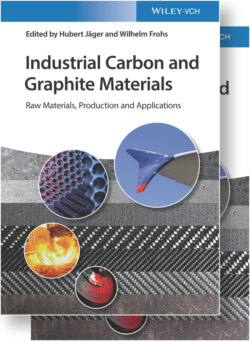Читать книгу Industrial Carbon and Graphite Materials - Группа авторов - Страница 304
6.1.3.3.1.1 Chamber Coking Process
ОглавлениеFigure 6.1.3.1 illustrates a flow chart of the process that in the Koppers process, air is injected to process SOP yielding hard pitch, which is charged into the chamber oven. Major equipment is constituted with a chamber‐type oven similar to the metallurgical coke oven as central equipment, a raw material feeding machine to a chamber oven, a pusher machine for discharging PC formed in the chamber oven, a quench car for cooling red hot PC pushed, a crusher for adjusting the grain size of PC, and equipment for processing oil and gas formed as by‐products. When hard pitch in the residual carbon content left as a coal after processing a raw material is charged into the chamber oven, equipment of preprocessing the pitch is available. Pitch is charged from the top of the chamber oven to produce by dry distillation carbonaceous PC free of ash. Table 6.1.3.2 [5, 6, p. 316] indicates a typical example of the major dimensions of the chamber oven and its operational capacity. The oven is slightly smaller in size than the coke oven, and a battery of ovens is composed of around five ovens much less than the coke ovens battery in which a few dozens of ovens are used. This is due to the very severe operational condition under which pitch is charged as a raw material so that the service life of the oven is short and around five years. The overall height of the oven is around 8 m, and the upper half of the oven is configured alternatively with the carbonization chamber and the gas combustion chamber in the width direction of the oven. The lower half of the oven is configured with the regenerative chamber for exchanging heat between the hot flue gas in the combustion chamber and the combustion air.
Figure 6.1.3.1 Process flow of Koppers process.
Table 6.1.3.2 Dimension and operational capacity of typical Koppers coke oven.
| Major dimension | Operational capacity per chamber | ||
|---|---|---|---|
| Height (mm) | 3000 | Amount of hard pitch charged (t/chamber) | 9.1 |
| Length (mm) | 11 800 | Process time (hr) | 18 |
| Width (mm) | 450 | Handling capacity of hard pitch (t/day) | 12.2 |
| Production volume of PC (t/day) | 9.2 |
Medium pitch (softening point: approximately 70 °C) or hard pitch (softening point: approximately 150 °C) obtained by injecting air into the medium pitch and large in the residual carbon ratio is used as a raw material. When medium pitch is used, the process for adjusting the hardness in hard pitch is omitted. Pitch is charged into a molten tank (approximately 300 °C) heated in a tubular furnace and then into the hardening vessel, in which air is injected to form hard pitch (yield: approximately 85%) followed by charging it into a circulation tank. Hard pitch in the circulation tank is circulated through a pipeline configured on the surface of the oven in the chamber. A plurality of inlets for charging pitch is configured on the ceiling of the carbonization chamber, and the pitch is charged into the carbonization chamber heated to approximately 1000 °C by opening the valve provided on the circulation pipe directly lying on it. Carbonization of pitch is completed after approximately 20 hours. After completion of carbonization, lids at both ends of the oven in the carbonization chamber are detached to push red hot coke out of the oven with a pusher machine into the quench car through the coke guide car. After the red hot coke is quenched using a water spraying system, a big block of coke is crushed to yield a product. A yield of the PC from medium pitch is around approximately 60%.
